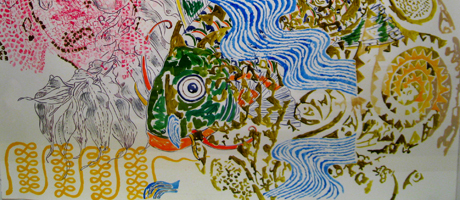By Menachem Wecker
Although it is not an exhibit sponsor, Amtrak deserves some of the credit for the Nancy Graves show currently at GW’s Luther W. Brady Art Gallery.
On a train to New York from Washington, Lenore Miller, M.F.A. ’72, director of University art galleries and chief curator, bumped into Joann Moser, a Smithsonian American Art Museum curator. Dr. Moser told Ms. Miller, that a Connecticut gallery had pitched a Nancy Graves show to her that she could not fit into the museum’s schedule. Did the Brady Gallery have any interest in the show, Dr. Moser wondered.
Knowing that Luther Brady, B.A. ’46, M.D. ’48, the gallery’s namesake, owned several of Ms. Graves’ works, Ms. Miller spoke with the Nancy Graves Foundation. Olivia Kohler, assistant director of University art galleries, looked through catalogs and Web sites to identify the works that would hang with several chosen pieces from Dr. Brady’s collection.
“We really got a museum-quality exhibition, something that could have gone up at the Smithsonian,” Ms. Kohler says.
Though abstract in orientation, the 16 pieces in the show “Nancy Graves: Inspired Vision –Sculpture, Paintings, Drawings” feature a variety of symbols, including hieroglyphics, Egyptian wall paintings, Native American and cave painting, Classical Greek and Roman heads, and anthropological and natural history references.
“Imaginary Time” (1988), a painting made of gouache (opaque watercolor), gold leaf, acrylic and watercolor, shows a green fish head which seems to have a river separating it from its body. But closer inspection reveals the fish’s scales and tail, though they blend in with brown outlines of Assyrian-styled chariots and horsemen.
“Metamorphosis is a really large part of Nancy Graves’ work,” says Ms. Miller, adding that some of the symbols have a “shamanistic quality.”
Ms. Graves (1939-1995), a graduate of Vassar College and Yale School of Art, was a student of anthropology, which is perhaps why bones are a frequent symbol in her work. One work in the show, a gouache painting on green graph paper dated 1971, is titled “Untitled Folder, 50 Hair Bones and Sun Disk.” The painting shows what looks like a hoop skirt with bones instead of fabric. A note on the graph paper reveals that a heavy black line “indicates feathers attached to end of rawhide.”
Unlike her first husband, famous minimalist sculptor Richard Serra, Ms. Graves treated her sculptures as canvases. “It is unusual to see painted sculpture,” Ms. Miller says. “It’s also unusual to see a woman artist who worked in all different media.”
According to Ms. Miller, the works’ bright colors are in line with Dr. Brady’s “colorful, textural, abstract expressionist” tastes. Students have also been responding to Ms. Graves’ bold palette, she says. A group of documentary film students even brought a camera to the gallery to interview Ms. Miller for a class project.
The exhibit opened at the Brady Gallery on Sept. 9 and closes Oct. 23, 2009.


